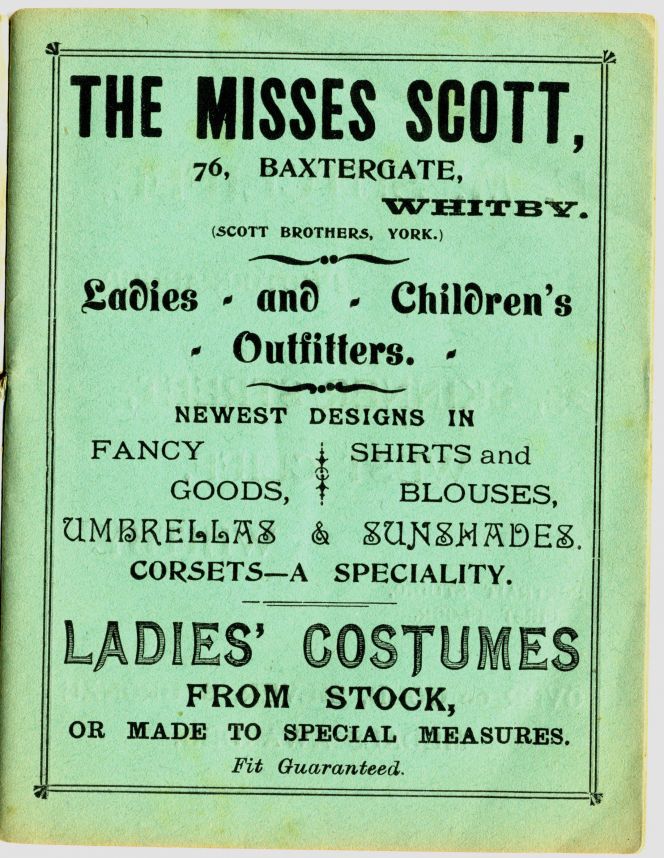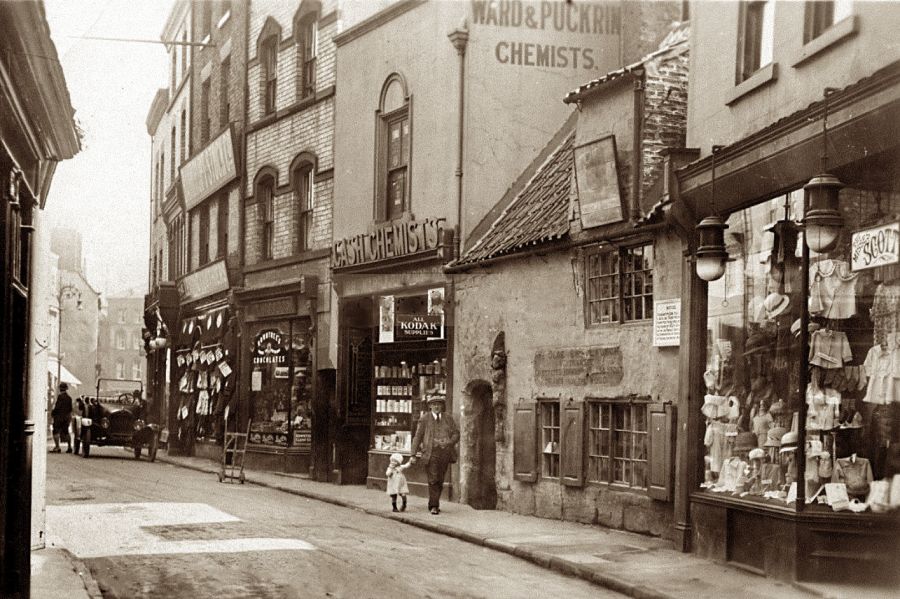ikfoundation.org
The IK Foundation
Promoting Natural & Cultural History
Since 1988


TEXTILE SHOPKEEPERS
– in a Coastal Town
The research project “The Textile History of Whitby 1700-1914”, which stretched over almost a decade and was published earlier this year, has left me with some documents, photographs and odd bits of facts not possible to fit into the book. Sources are sometimes linked to parts of the monographs and, in other cases, originating either before the year 1700 or after 1914. The hope is that a continuation of textile essays with connections to the coastal community of Whitby can reveal some further previously unknown historical events and details. This first case study will give a glimpse of the female shopkeepers The Misses Scott, who can be traced to a number of primary sources dating from the 1890s to 1918 – via the local newspaper Whitby Gazette, photographs, censuses and directories.
-900x687.jpg) The Misses Scott’s establishment was immortalised in this photograph by Frank Meadow Sutcliffe at Bridge End circa 1895: ‘Hosiers The Misses Scott & Glovers’ & ‘ The Misses Scott Ladies and Children’s Outfitter’. (Courtesy of: Frank M. Sutcliffe, Whitby Museum, Photographic Collection).
The Misses Scott’s establishment was immortalised in this photograph by Frank Meadow Sutcliffe at Bridge End circa 1895: ‘Hosiers The Misses Scott & Glovers’ & ‘ The Misses Scott Ladies and Children’s Outfitter’. (Courtesy of: Frank M. Sutcliffe, Whitby Museum, Photographic Collection).The Misses Scott, Ladies’ and Children’s Outfitters at Bridge End advertised in Whitby Gazette in the period 1894 to 1912 and announced in April of their first year: ‘Miss Scott’s Return from the London Markets. A Grand Selection of New Spring Goods – Stylish Costumes, Dresses, Pelisses, Coats and Capes, Pinafores, Sashes and Ribbons. Hoods, Bonnets, Mob Caps, Handkerchiefs, Gloves.’ A few years later, in 1897, and by now in Baxtergate, they laid particular emphasis on underclothes, including some in ‘Hand-Made Irish Linen’. Ireland had long been known for top-quality linen, so this was often used as a selling point in advertisements. For ten years, the firm did not advertise at all in the paper, but in June 1912, the season inspired them to inform their customers of a ‘New Delivery of all the latest Novelties in Summer Blouses’.
 The Misses Scott’s, at the new address 76 Baxtergate in Newton’s Guide to Whitby of 1903 and two years earlier they were also listed in Cook’s Directory of 1901 – ‘Scott, Misses, 76 Baxtergate’ below the heading ‘Ladies’ and Children’s Outfitters’.
The Misses Scott’s, at the new address 76 Baxtergate in Newton’s Guide to Whitby of 1903 and two years earlier they were also listed in Cook’s Directory of 1901 – ‘Scott, Misses, 76 Baxtergate’ below the heading ‘Ladies’ and Children’s Outfitters’.The Whitby Gazette was not the only source for advertisements, which can be studied via the guidebook above where ‘The Misses Scott 76 Baxtergate’ was one of the advertising businesses. These two ladies specialised in Ladies and Children’s outfitting, according to both their advertisements in the local paper between 1894 and 1912, Cook’s 1901 directory, and the census of the same year in which the 28 year-old ladies’ outfitter Sarah Scott is listed in Elgin Street.
 This image taken circa 1918 by an unknown photographer, is evidence for that the Misses Scott by now had moved their shop for a third time to more spacious premises. At this location – 30 Baxtergate – the establishment had useful large-sized shop windows with plenty of room for showing off their assortment of children’s clothes, ladies hats etc. It is however unclear for how long the ladies and children’s outfitter existed in town. (Private ownership).
This image taken circa 1918 by an unknown photographer, is evidence for that the Misses Scott by now had moved their shop for a third time to more spacious premises. At this location – 30 Baxtergate – the establishment had useful large-sized shop windows with plenty of room for showing off their assortment of children’s clothes, ladies hats etc. It is however unclear for how long the ladies and children’s outfitter existed in town. (Private ownership).It seems to have been a regular habit for shop owners in Whitby – judging by advertisements and announcements in Whitby Gazette – to move to more suitable, larger, smaller (rarely mentioned) or, most importantly, better-positioned premises to attract each and everyone's desired clientele of customers. Here, these circumstances are exemplified by two other shopkeepers, firstly an advertisement from the spring of 1895: ‘Notice of Removal. Robert Spanton – Hatter, Hosier and Shirt Maker, Desires to inform his Friends and Public generally that he has removed to the large commodious Corner Premises, immediately opposite his Old Shop.’ While locals and visitors twenty-five years earlier were informed that: The General Draper at 9 Flowergate, Henry Duck in the spring of 1870 noted ‘a Large Display of New Goods in his Extended Premises’ with not only the usual drapery items but every imaginable accessory for women’s clothing: ‘Crinolines, Sunshades, Umbrellas, Stays and Corsetts, Ribbons, Feathers, Flowers, Lace, Hosiery, Gloves, Handkerchiefs, Veils, Chemisetts etc.’
Sources:
- Hansen, Viveka, The Textile History of Whitby 1700-1914 – A lively coastal town between the North Sea and North York Moors, London & Whitby 2015 (See this monograph for full Bibliography and a complete list of notes about the Misses Scott).
- Whitby Gazette, 1870, 1894, & 1895 (Whitby Museum, Library & Archive).
More in Books & Art:
Essays
The iTEXTILIS is a division of The IK Workshop Society – a global and unique forum for all those interested in Natural & Cultural History from a textile Perspective.
Open Access essays, licensed under Creative Commons and freely accessible, by Textile historian Viveka Hansen, aim to integrate her current research, printed monographs, and earlier projects dating back to the late 1980s. Some essays feature rare archive material originally published in other languages, now available in English for the first time, revealing aspects of history that were previously little known outside northern European countries. Her work also explores various topics, including the textile trade, material culture, cloth manufacturing, fashion, natural dyeing, and the intriguing world of early travelling naturalists – such as the "Linnaean network" – viewed through a global historical lens.
For regular updates and to fully utilise iTEXTILIS' features, we recommend subscribing to our newsletter, iMESSENGER.
been copied to your clipboard




– a truly European organisation since 1988
Legal issues | Forget me | and much more...
You are welcome to use the information and knowledge from
The IK Workshop Society, as long as you follow a few simple rules.
LEARN MORE & I AGREE







